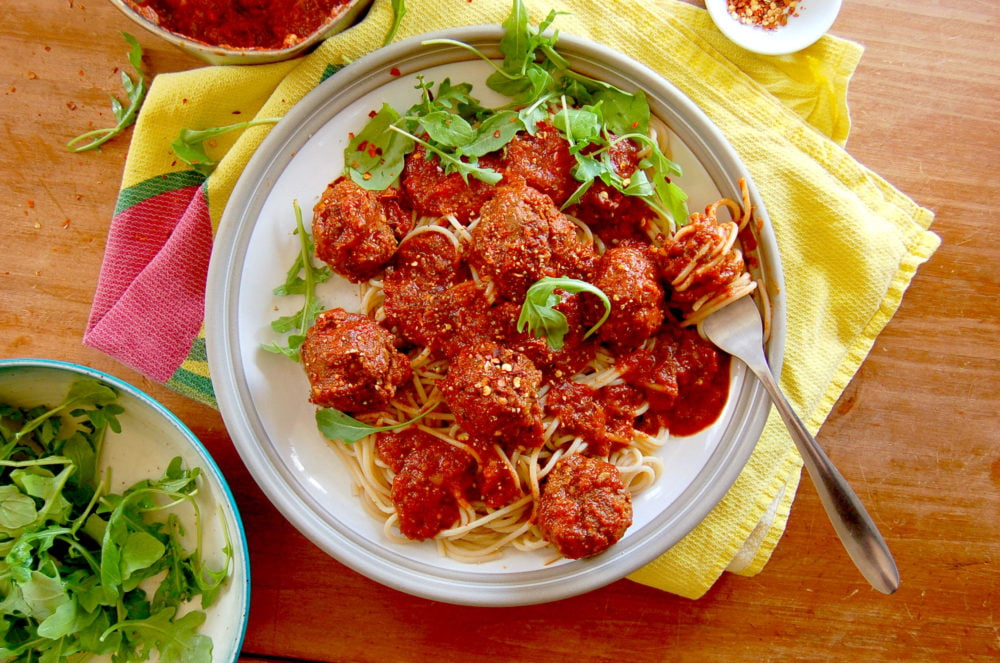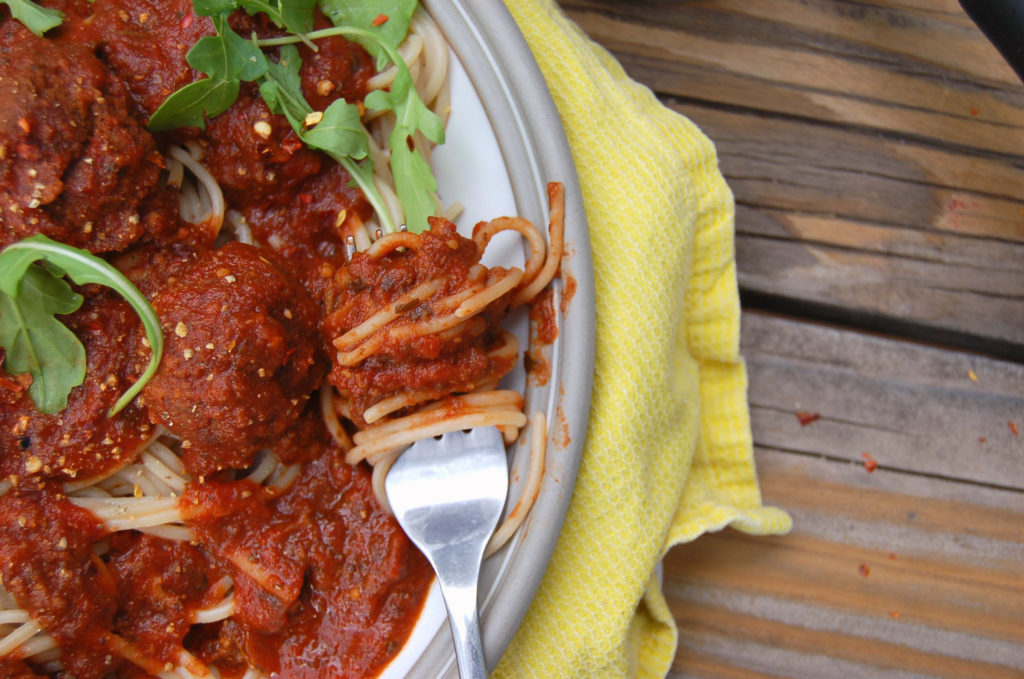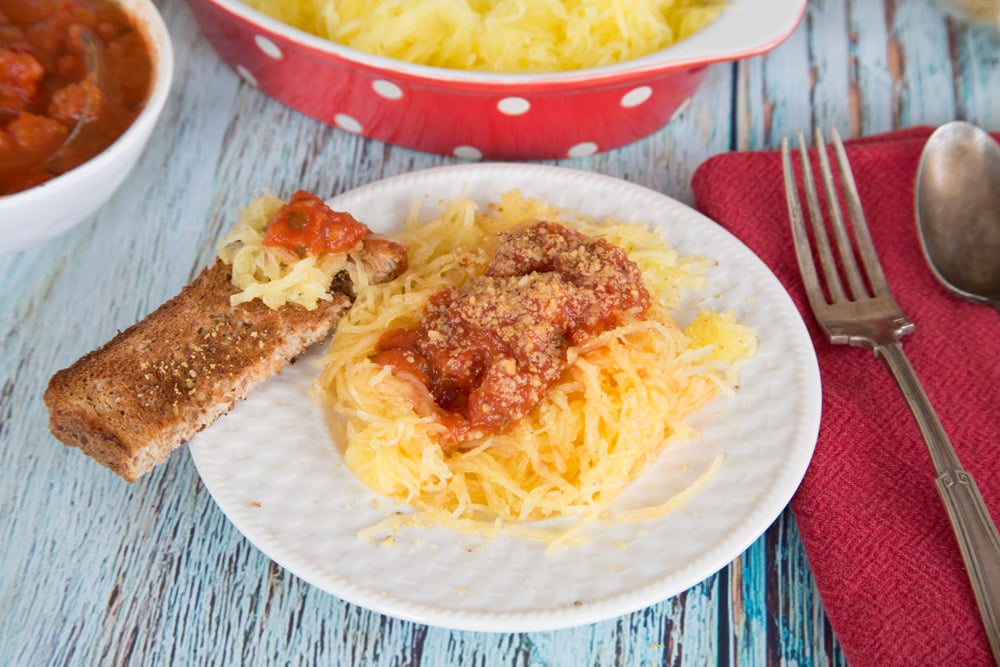How Do Vegans Get Their Protein and How Much Protein Do You Need? Here’s the 411 + Protein Packed Plant Based Meatballs

By Molly Patrick
Nov 18, 2014,
By Molly Patrick
Nov 18, 2014,
One of the most common questions we get asked is; How do vegans get their protein and how much protein do you need?
Well, bring momma an apple because you’re about to be schooled.
Protein is a macronutrient, along with fat and carbohydrates. It was discovered in 1839.
Protein is made up of 20 different amino acids, the building blocks of every structure and function in the human body. Pretty important stuff, indeed.
There are 8 or 9 amino acids that our body doesn’t make on its own. These are called essential amino acids and we must get them elsewhere since the bod isn’t dishing them out.
Each protein has a different arrangement of amino acids. When we eat on protein, our body breaks it down and puts the amino acids back together to form whatever proteins we need.
Think of protein as the alphabet. The alphabet is made up of letters (amino acids) and those letters can be rearranged to form new words, just like amino acids can be rearranged to form new proteins.
Are you with me so far or do I need to take a break and insert some toilet humor?
Okay, click here and then come back to me.
I know!
Let’s continue and find out why animal protein has always been sensationalized.
When we consume proteins that have a similar amino acid arrangement to those in our body, we synthesize that protein effectively.
Not surprisingly, the amino acid arrangement in animals is most similar to ours.
Cha-ching: this is what led to the thinking that animal protein is the most superior, “high quality” protein on the block.
But hold the phone…
Just because animal protein’s amino acid structure is similar to ours, doesn’t make it any more high quality than protein found in plants. I’ll explain, but first…
Tell me you didn’t need that!
Carrying on.
There have been huge epidemiological studies and loads of clinical studies that have been done on the link between animal protein and degenerative disease. The results are rather shocking. What’s more shocking is that most people know nothing about it.
Dr. T. Colin Campbell is a scientist who has been studying nutrition and protein since the 70’s. He was one of the scientists who helped conduct the biggest epidemiological study to date on humans and diet.
This study was called The China Project which he later wrote a book about called The China Study.
Here’s a recap of some of what he and his colleagues observed over the course of the study.
1. Eating animal protein leads to elevated blood cholesterol levels.
Even more so than from saturated fat. High cholesterol is one of the precursors to heart disease.
2. Eating animal protein enhances the likelihood of osteoporosis.
But wait, doesn’t milk build strong bones? Actually, it’s the opposite. Animal protein creates an acid-like environment in our tissues. The body cannot tolerate too much of this acid-like environment so is always trying to neutralize it. To neutralize this effect, the body draws from the most alkaline substance it can find which happens to be the calcium in bones. This weakens bones and potentially leads to osteoporosis.
3. Eating animal protein helps initiate type 1 diabetes.
Especially when casein, the protein in dairy, is consumed.
4. Eating animal protein increases the production of growth hormones.
Growth hormones have been shown to elevate cancer growth.
5. Animal protein increases the rate at which cells divide and is linked to Alzheimer’s disease, kidney stones and many other degenerative diseases.
During the study, the source of animal protein didn’t matter. Animal protein is animal protein, whether it’s in the form of chicken breast, ground turkey, roast pork or a tall glass of milk. They found that dropping the animal protein and swapping it out with whole plant foods showed to have the exact opposite effect on every point mentioned above.
Not only did way more whole plant foods and way less animal foods protect against degenerative disease, it also reversed disease in many cases, even when there was a genetic predisposition factor involved.
AND even though the people who ate a diet of whole plant foods consumed more calories per day than the people who got their protein from animals, the first group were considerably leaner and had less body fat than the people getting their protein from animals.
It’s all about the quality of the calories, not the quantity.
Now that we know animal protein isn’t so quality after all, it’s time to take a look at the alternative. And that alternative is plants.
Did you know that every single plant has protein and unless you’re starving yourself, it’s virtually impossible not to get enough? If you eat a wide variety of plant foods, your body will get all the protein it needs, and then some.
How much is enough?
We need about 8% – 10% of our calories to come from protein each day. Put in another way, we need around 0.8 grams of protein for every kilogram, or 0.36 grams for every pound we weigh each day.
People who follow a whole-food plant-based diet generally get 8%-10% of their calories from protein. Perfection!
I’ll take myself as an example and break this down.
I weigh 135 pounds, so I would take 135 x 0.36 to get 48.6.
This means I need around 48.6 grams of protein each day.
48.6 x 4 (because there are 4 calories in 1 gram of protein) = 194.4 calories from protein.
194.4 divided by 2,000 (my average daily calorie intake) = .0972.
So there it is. I need almost 10% of my daily calories to come from protein, or 48.6 grams per day. This falls right in the 8-10% range.
To get 48.6 grams I would need to eat:
1 cup of garbanzo beans (39g)
1/2 cup of quinoa (4g)
5 oz. of tofu (12g)
Or I could eat:
1 cup of collard greens (4 grams)
2 pieces of sprouted grain bread (14g)
1 cup of mushrooms (5g)
1/4 cup of raw almonds (7.6 grams)
1 cup of cooked lentils (18g)
The possibilities are endless and there is absolutely no shortage of protein when eating a plant-based diet.
Here’s another thing to consider. Unlike a massage, more protein is not better.
On average, Americans are getting 18-20% of their calories from protein and this is a conservative figure.
Too much protein taxes our liver and can lead to gout, along with certain types of cancers and a slew of other health issues.
I can tell you from personal experience there is physically no need for animal protein in the diet. I’ve never eaten meat in my life and I’ve been vegan since 2008. I’m doing just fine. Getting protein from plants is not only possible, it’s also damn tasty.
Join Clean Food Dirty Girl and we’ll show you how. You’ll have the option of viewing nutrition information so you can track your protein if you want!

Ingredients
- 1 cup dry lentils 180g
- ½ cup dry millet 95g
- 1 cup yellow onion 130g
- 1 cup walnuts 90g
- ¼ cup tomato paste 60g
- 1 cup fresh parsley 20g
- 5 garlic cloves minced
- 1 teaspoon dried oregano
- 1 teaspoon dried basil
- 2 teaspoons salt 12g
- ½ cup water 120ml
- ¼ cup rice flour 40g
Instructions
- Cook lentils by bringing 4 cups of water (945ml) to a boil.
- Add 1 cup of lentils, turn heat to low and simmer for 50 minutes until lentils are cooked, stirring occasionally.
- Place cooked lentils in a large mixing bowl.
- Cook millet by placing 1 cup of water (250ml) and 1/2 cup of millet in a pot.
- Bring to a simmer, turn to low and cook for 20 minutes, stirring occasionally.
- Place cooked millet in the mixing bowl with the lentils.
- Add the remaining ingredients, except for the rice flour to the mixing bowl (onion, walnuts, tomato paste, parsley,garlic, oregano, basil, salt and water).
- Stir mixture so that all of the ingredients are combined.
- Place the mixture in a food processor and process until smooth (you may have to do this in two batches depending on the size of your food processor).
- Once all of the meatball mixture has been processed, place it back in the large bowl and sprinkle in the rice flour.
- Stir until the rice flour is mixed in.
- Preheat oven to 350°.
- Take the mixture and roll into whatever size meatballs you like. (if you make them about the size in the picture, you will get around 25 meatballs)
- Place them on a baking sheet covered with parchment paper and bake for 35 minutes.
Notes
Have a beautiful week and remember, what you truly desire, desires you just as much.
39 Comments
Leave a Comment
Love the food that loves you back
Get instant access to thousands of plant-based recipes and meal plans, no credit card or perfection required.


















Yum! Im going shopping for ingredients tomorrow. I despise the flavor of walnuts,almonds or cashews should work as a sub don’t you think?
Any nit should work! Let me know how they turn out 🙂
And when I said “nit” I meant “nut”. lol
This is a great article molly (interludes included) but I felt compelled to point out something you touch on. You attack animal proteins by stating “Eating…”. But later you hit on the real issue. OVER consumption of protein is the real culprit which is much easier to do eating animal protein than plant based. The fact still remains that animal protein does contain the most complete protein profile. I am a low carb pundit and too often when people hear low carb they think High protein which is totally false. Great article in any case!
Hi Richard,
You are absolutely correct, humans process animal protein very effectively.
The fact still remains that animal protein causes a plethora of other health issues that are avoidable by eating a healthy plant-based diet. I’m not suggesting that a plant-based diet is for everyone. Thanks for sharing your thoughts!
The problem I’ve always had with plant based proteins is not having the complete amino acid profile that you get with animal proteins. I have recently been introduced to a raw protein, which is completely plant based, and does have the complete amino acid profile. I’m loving it! I don’t get the indigestion I always got with animal based proteins, like whey. It gives me a great energy boost. And, I’m getting the protein I need. I’d have to disagree on the protein amounts mentions. I agree that 8-10% is all you need to remain healthy. However, athletes, or anyone wanting to build muscle mass would need to consume more to do so. I don’t always have time to consume what I would need to eat in vegetables to get the protein I would need just from that. This new protein powder has made that much easier to do.
Hi Tara,
In the 80’s and 90’s it was thought that if you eat a plant based diet then you must pair your food in such a way that gives you complete amino acid structure. This has since been debunked and we now know that if we eat a variety of plant foods our body does a fine job of putting them back together how it needs.
In regards to athletes, there are lots of plant based athletes who do just fine with 8% – 10% protein diets. At the end of the day, it’s all about how you feel though. If you feel like you need more and your body performs better with more protein, then by all means – have at it!
Thanks for chiming in 🙂
Molly
I never claimed to have to pair your food in such a way. I understand your body can put them together. However, as you said, you have to eat a variety of different foods in order to complete the amino acid profile, and I just prefer getting my protein from a source that has all of the aminos I need. One isn’t necessarily better than the other! I, unfortunately, don’t digest animal proteins easily though, which is why I was so psyched when I found a plant based protein that had the complete amino acid profile. I didn’t have to worry about whether I was getting all the aminos I needed because they are all there in my protein, plus it’s plant based, raw, and completely organic. This is just my preference. There is nothing wrong with going about it with multiple plant based proteins sources.
Rock on with your bad self, lady! Everyone is different and there is absolutely nothing wrong with that 🙂
Tara, twice you mentioned a “plant-based complete protein”, but you haven’t said what it’s called! Let us all know, but my guess would be quinoa. Am I right?
Hi Molly! I just discovered your blog, thanks to Kathy at Finding Vegan. I’m so happy she put together that awesome blogger FB group!!!
3 Thoughts.
First, you are quite funny. I laughed out loud several times as I read this very informative post. Thank you!
Second, those lentil balls look outstanding. I will be trying out your recipe!
Third, I can’t wait to find time to read more of your posts.
Hi Linda,
So glad you found me! Let me know how the yummy lentil meatballs turn out!
I have celiac so millet is a no-no for me. What could I use instead of?
And the lentils should be drained?
Millet is gluten free: http://www.goldenprairie.com/millet-a-gluten-free-grain.html
Hi Libby, I am wondering why you can’t have millet.
Like Wendy pointed out it is gluten free.
Let me know!
Molly
I apologize. I was just diagnosed and am still learning about the gluten free life. I’ll give this recipe a try 😀
Hey Libby -no worries, it’s hard to navigate at first! If you ever have any questions, please let me know. [email protected]
I believe in what you said wholeheartedly. I have been vegan for 9 months and I came up short on my protein intake on recent tests. This information is invaluable! I really did find your article useful. But one sentence made me chuckle the way you wrote it. “I have never eaten meat in my entire life, I have been vegan since 2008 . . . ” The way I read it makes it sound like you are only 6 years old. I have a warped mind. I know that’s not what you meant. I need more protein to start thinking clearly again. Thank you so much.
Hi Mark – That is funny!
Yup – I’m definitely not 6.
Glad you found my article useful 🙂
Molly
Karen, I made this recipe with leftover pecans. It tasted fantastic!
I don’t know where to get millet. Can I substitute rice or quinoa?
Hi Carol – you can sub quinoa for millet, yes. You should be able to find millet the same place you find quinoa, but you can definitely swap it if you can’t find it 🙂
Can you recommend a non-grain sub for the millet? Son has multiple food sensitivities, including all grains. A second type of nuts or canned beans maybe? What would work with all the flavors?
Hi Laura,
You can always double the lentils.
Or maybe try kidney beans!
Let me know how they turn out.
xo
Molly
“even though the people who ate a diet of whole plant foods consumed more calories per day than the people who got their protein from animals, the first group were considerably leaner and had less body fat than the people getting their protein from animals” Is this also a conclusion of the China Study or did it come from a different source? I can believe it, I’d just love to read up on this phenomenon more! Thanks!
Hi Molly, just wondering if this recipe is possible to make without a food processor?
Hi Anni –
If you have a blender and a potato masher I think you could bang it out just fine 🙂
xo
Molly
Going to make it today!As you suggested I cooked the lentils and the millet yesterday!! Can’t wait!!I will make this beautiful balls with soba noodles and Alfredo souse!Thank you Molly!!
What would you suggest for the many recipes that use nuts? My husband can’t have nuts of any kind:( Found a link to your blog after doing a 15 day Reboot.
Hi Sharon, your best bet is to join Molly’s amazing private Facebook group and ask for substitution ideas for individual recipes, as it will differ somewhat for each one. 😉
xo
Meghann
Team Dirty Girl
My friends have been subscribers to you for some time now and since they are my friends, they have turned me on to this. I am just starting out and not 100% vegan by any means. I still eat eggs and fish but have as of today cut out chicken and I haven’t eaten red meat in ages. Dairy I cut out in January when I did a clean eating cleanse and it jumpstarted all of this. Anyway, looking forward to changing my habits one habit at a time. Also need to sneak it all on to my husband’s plate…LOL
Excited about this new journey. Going to try this recipe this week! Wish me luck
Thank you! Very Helpful! Have you ever used an app to track protein or other nutrients? Most track calories, but if there were such an animal (pardon the pun) it would help. Your article calculations showed me my husband 6’2″ was not getting enough protein. Thanks for all your suggestions! And I can’t wait to try this recipe!
Hi Tammy Jo!
Thanks for stopping by – I was totally looking for a meat ball recipe on the site earlier today and this one didn’t pop up so we need to fix the search results, thank you!!!
I personally have used a nutrient tracker to check my own intakes for short periods of time when I was straddling between eating mostly WFPB and still relying on convenience foods. I think the trackers are useful to get a baseline of areas that might be glaringly inadequate (usually micronutrients). It’s fairly simple (although tedious) to enter our recipes into a nutrient tracker and get a good idea of the nutrient composition since they are whole foods. However, Molly has written about why she stays away from calorie / nutrient trackers and so we do not provide this information for our meal plans.
While there are certain nutrients plant based eaters need to be mindful of (Part 1, Part 2), and unless you are further restricting foods within the plant and/or fungi kingdoms, protein should not be one of them.
I hope you enjoy those meat balls if you make them!
Karen
Team Dirty Girl
Do these freeze well?
Hi Peggy – these should freeze just fine. ~Karen
I was wondering if you can overeat plant protein the same way you can animal protein? I love beans! But they are very high in protein, will that protein cause my liver to be overworked?
Hi Shaina, it probably is possible to overeat plant protein. Because beans have the bulk of fiber, it would be really hard (probably impossible) to eat so many beans that you overdo your protein on a consistent basis. Unlike eating animal products, which are dense in protein but have no fiber. Overdoing protein on a plant based dietary pattern would probably require using plant based protein supplements that skew the ratio of protein to be really high in comparison to carbohydrate, fat, fiber and other nutrients. Also, as far as I know, the consideration for overeating protein has to do with the kidneys rather than the liver. ~Karen
By far my favourite plant based meatball recipe to date! Loved the flavour and the texture- I used some leftover quinoa salad instead of Millet for convenience haha. My only problem was they seemed to cook very well on the outside but were really soft, almost runny, inside. Any ideas what I might have done wrong or could improve for next time? I ended up flattening them like little falafels and cooked them for another half hour and they came out perfect!
Hi Veronica, So glad that you enjoyed these as falafel patty meatballs 🙂 ! Quinoa is a perfect sub in place of millet. This recipe is an older one. As far as a runny texture on the inside, I’m going to check with Molly. We may retest this recipe (since it’s older) and we’ll reply back when we do. For now, though, generally it’s better to follow the gram / mL measurements rather than cup measurements. Metric weights are more exact. ~Karen